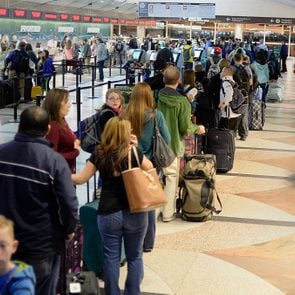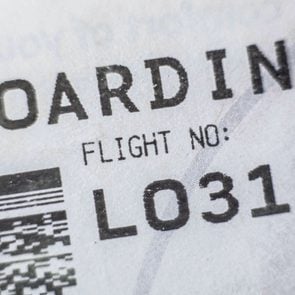The Real Reason Why Pilots Can’t Have Facial Hair
Updated: Aug. 23, 2024

You probably won't see many airline pilots with big, bushy beards—or any facial hair at all. Here's the real reason why airline pilots can't have beards.
Whether short and scruffy or long and full, beards give guys a way to express themselves. And they’re everywhere! Just think about how many of your friends and loved ones skip shaving for a few days, grow a ‘stache or maintain a full beard. Facial hair trends come and go, but according to a survey by Statista, as many as 44% of U.S. men keep some kind of beard. Yet chances are, few of them are airline pilots—some industry regulations prohibit pilots and often cabin crew from having beards. So why can’t airline pilots have beards?
The answer is right under your nose (and mouth). We talked to an expert at a leading airline association and dug into Federal Aviation Administration regulations to learn why a decades-old advisory recommends pilots be clean-shaven and why facial hair matters at all.
Read on to learn why airline pilots can’t have beards—the answer is bound to surprise you!
Get Reader’s Digest’s Read Up newsletter for more news, travel, tech, humor and fun facts all week long.
Why can’t airline pilots have beards?
The reason most airlines don’t allow pilots to have beards boils down to two things: history and safety.
Once upon a time, the majority of airline pilots joined commercial carriers as a second career, after they’d retired as pilots in the U.S. Navy, Air Force or Marines. While there are now aviation academies that train new commercial pilots, most airlines still take their cues from U.S. military dress and grooming policies. That means short hair and no facial hair, except for Navy SEALs and other special forces, who are allowed to have beards in the field. Otherwise, in the U.S. military, exemptions to the no-beard policy are possible only for religious motives or for those who suffer from skin conditions exacerbated by shaving.
U.S. airlines are free to set their own rules on whether pilots can have beards. But these holdovers from military tradition, combined with airlines wanting to err on the side of safety (more on that later), mean you’ll seldom see a pilot with facial hair.
Delta, Southwest, United, American Airlines and JetBlue, for example, do not allow cockpit crew to wear beards or even goatees, though some allow a neatly trimmed mustache that doesn’t extend below the corners of the mouth. Sideburns are allowed, to an extent—they must be trimmed to mid-ear and can’t be too bushy. Hawaiian and Allegiant airlines permit their pilots to maintain short, evenly trimmed and non-patchy beards.
Most airlines that impose no-beards policies on cockpit crew apply the same rule to cabin crew. That means you may not see many male flight attendants with facial hair. If they do have it, it’s likely trimmed very neatly and close to the skin.
OK, but where do safety concerns come in, and what do they have to do with this clean-shaven pilot trend? To understand that, we need to look to the FAA circa 1987.
What does the FAA say?
Beyond looking to military practices, airlines also lean on a 1987 FAA advisory that connects facial hair with oxygen mask safety. There’s a reason the 37-year-old report is still cited today: In the unlikely event of an onboard emergency in which oxygen masks are deployed, either in the cockpit or throughout the plane, it’s up to the cockpit crew to restore aircraft stability or get the airplane safely on the ground. They need to get those oxygen masks on quickly and safely to ensure they stay conscious and lucid in an emergency situation. And beards could potentially get in the way of that.
Here’s what the FAA advisory has to say:
“Bearded crew members should be aware that oxygen mask efficiency is reduced by the presence of facial hair. Demand masks, such as those used in protective breathing equipment, many times cannot be donned rapidly nor seal effectively when used by bearded individuals. This can adversely affect the performance of the mask and reduce crew member awareness, capability and performance. Flight attendants should be aware that their job-related physical activity reduces time of useful consciousness and increases respiratory exchange rates. These factors, combined with the reduced efficiency of continuous flow oxygen masks associated with beards, could produce physiological symptoms that might reduce the flight attendant’s ability to perform their safety-related duties.”
In plainer language, the advisory says that a pilot’s beard can prevent an oxygen mask from sealing to his face, so he won’t get a sufficient amount of oxygen. And reduced oxygen can result in disorientation, loss of consciousness or even death. When there’s a midair emergency, pilots and co-pilots are definitely the folks we want conscious and lucid, right?
Is there a rule against facial hair for pilots?
Technically speaking, pilots can have facial hair, says Marli Collier, the managing director of Airlines for America, the trade association for the country’s leading passenger and cargo airlines. The FAA doesn’t have a policy that prohibits it.
Give that 1987 advisory another read, and you might notice the words can, could and might. That’s because the FAA statement is pointing out a potential link, not guaranteed disaster for bearded pilots. Remember, it’s an advisory, not a set policy. “The FAA does not have such rules,” a spokesperson for the agency tells Reader’s Digest, “but some airlines prohibit pilots from having beards or restrict their length to ensure oxygen masks can fit securely.”
So it’s up to airlines to decide how closely they want to adhere to the recommendation. And so far, it seems like most choose to adopt the FAA advisory as corporate policy.
Should I be concerned if my pilot has a beard?
The FAA beard advisory was released nearly 40 years ago. Since that time, technological developments and improvements in air traffic control communications have made air travel significantly safer, with U.S. carriers, in particular, ranking among the safest airlines in the world. Some researchers have even cast doubt on the 1987 FAA advisory, saying it was created for oxygen equipment that’s no longer in use.
“Any discussion around pilot facial hair stems from operational concerns, specifically around the ability of the pilot’s oxygen mask to seal properly—pilots have a different style oxygen mask in the cockpit than passengers in the cabin,” Collier says. “However, the design of the pilots’ oxygen masks has evolved from a nose and mouth with separate goggles. Today, most airlines equip their flight decks with a quick-donning full-face mask design, which makes it easier and quicker to put the mask on and less susceptible to leaks and improper donning of the mask.”
The bottom line? Bearded pilots probably aren’t going to have issues with their oxygen masks.
Your chances of being on a plane where the oxygen masks deploy are incredibly slim, and your pilot has a minimum of 1,500 hours of experience—probably much more. Beard or no beard, he and his co-pilots are going to do everything in their power to resolve an emergency situation and get passengers and crew to the ground safely.
About the expert
|
Why trust us
At Reader’s Digest, we’re committed to producing high-quality content by writers with expertise and experience in their field in consultation with relevant, qualified experts. We rely on reputable primary sources, including government and professional organizations and academic institutions as well as our writers’ personal experiences where appropriate. We verify all facts and data, back them with credible sourcing and revisit them over time to ensure they remain accurate and up to date. For this piece on why airline pilots can’t have beards, Elizabeth Heath tapped her experience as a longtime travel journalist to ensure that all information is accurate and offers the best possible advice to readers. Read more about our team, our contributors and our editorial policies.
Sources:
- Marli Collier, managing director and spokesperson for Airlines for America; email interview, August 2024
- FAA spokesperson; email interview, August 2024
- Statista: “Share of male consumers who have a beard in the United States as of June 2017, by age group”
- FAA: “The Influence of Beards on Oxygen Mask Efficiency”
- AVweb: “Pilot Beard Ban Debunked”



